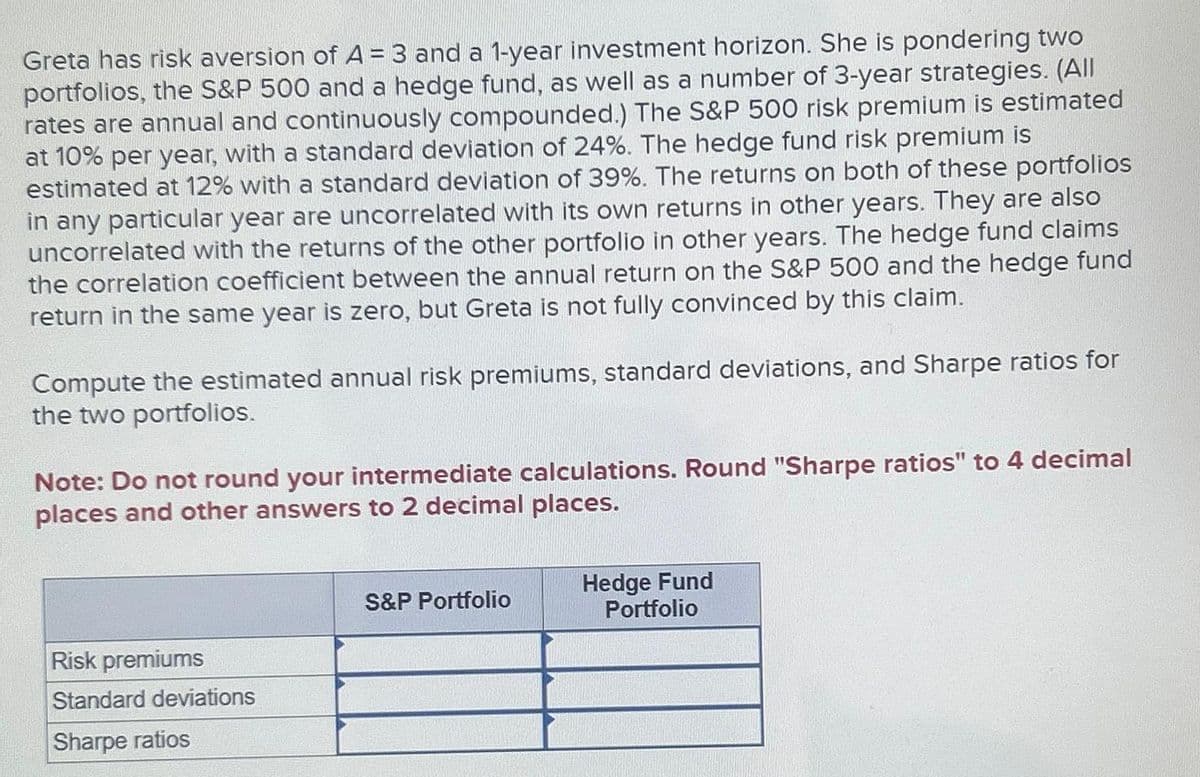Greta has risk aversion of A = 3 and a 1-year investment horizon. She is pondering two portfolios, the S&P 500 and a hedge fund, as well as a number of 3-year strategies. (All rates are annual and continuously compounded.) The S&P 500 risk premium is estimated at 10% per year, with a standard deviation of 24%. The hedge fund risk premium is estimated at 12% with a standard deviation of 39%. The returns on both of these portfolios in any particular year are uncorrelated with its own returns in other years. They are also uncorrelated with the returns of the other portfolio in other years. The hedge fund claims the correlation coefficient between the annual return on the S&P 500 and the hedge fund return in the same year is zero, but Greta is not fully convinced by this claim. Compute the estimated annual risk premiums, standard deviations, and Sharpe ratios for the two portfolios.
Greta has risk aversion of A = 3 and a 1-year investment horizon. She is pondering two portfolios, the S&P 500 and a hedge fund, as well as a number of 3-year strategies. (All rates are annual and continuously compounded.) The S&P 500 risk premium is estimated at 10% per year, with a standard deviation of 24%. The hedge fund risk premium is estimated at 12% with a standard deviation of 39%. The returns on both of these portfolios in any particular year are uncorrelated with its own returns in other years. They are also uncorrelated with the returns of the other portfolio in other years. The hedge fund claims the correlation coefficient between the annual return on the S&P 500 and the hedge fund return in the same year is zero, but Greta is not fully convinced by this claim. Compute the estimated annual risk premiums, standard deviations, and Sharpe ratios for the two portfolios.
Chapter8: Analysis Of Risk And Return
Section: Chapter Questions
Problem 5P
Related questions
Question

Transcribed Image Text:Greta has risk aversion of A = 3 and a 1-year investment horizon. She is pondering two
portfolios, the S&P 500 and a hedge fund, as well as a number of 3-year strategies. (All
rates are annual and continuously compounded.) The S&P 500 risk premium is estimated
at 10% per year, with a standard deviation of 24%. The hedge fund risk premium is
estimated at 12% with a standard deviation of 39%. The returns on both of these portfolios
in any particular year are uncorrelated with its own returns in other years. They are also
uncorrelated with the returns of the other portfolio in other years. The hedge fund claims
the correlation coefficient between the annual return on the S&P 500 and the hedge fund
return in the same year is zero, but Greta is not fully convinced by this claim.
Compute the estimated annual risk premiums, standard deviations, and Sharpe ratios for
the two portfolios.
Note: Do not round your intermediate calculations. Round "Sharpe ratios" to 4 decimal
places and other answers to 2 decimal places.
Risk premiums
Standard deviations
Sharpe ratios
S&P Portfolio
Hedge Fund
Portfolio
Expert Solution
This question has been solved!
Explore an expertly crafted, step-by-step solution for a thorough understanding of key concepts.
This is a popular solution!
Trending now
This is a popular solution!
Step by step
Solved in 3 steps with 2 images

Knowledge Booster
Learn more about
Need a deep-dive on the concept behind this application? Look no further. Learn more about this topic, finance and related others by exploring similar questions and additional content below.Recommended textbooks for you

EBK CONTEMPORARY FINANCIAL MANAGEMENT
Finance
ISBN:
9781337514835
Author:
MOYER
Publisher:
CENGAGE LEARNING - CONSIGNMENT

EBK CONTEMPORARY FINANCIAL MANAGEMENT
Finance
ISBN:
9781337514835
Author:
MOYER
Publisher:
CENGAGE LEARNING - CONSIGNMENT